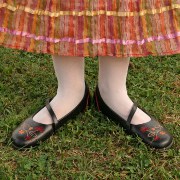My husband has them. One of my sons does, too. As for me, I think I have the highest arch known to man. If you have flat feet, you probably know it already. Perhaps you have seen your wet footprint on the pavement or on the bathroom floor and taken note of the fact that the imprint is perfectly flat, bearing no indication of an arch. A normal footprint has a wide band that connects the ball of the foot to the heel, bearing an indentation on either side of the foot. If someone has a high arch, that indentation is large and the connecting band is quite narrow. When someone has a flat foot, a nearly full footprint is noticeable, showing almost no inward curve where the arch normally is.
For many adults, a low arch or a flat foot is painless and typically causes no problems. However, if pain is present, it could be indicative of a congenital abnormality or the result of some sort of injury sustained to the muscles and tendons of the foot. Sometimes flat feet can cause pain in the lower back. If the condition continues, the individual may have difficulty in walking, climbing stairs or even wearing shoes.
Symptoms of flat feet that necessitate an examination by a doctor include:
*Your feet tire easily or they become painful when standing for appreciable amounts of time.
*You find it difficult to stand on your toes or to even move your heel or mid-foot around.
*You notice substantial pain in your heel or arch area, and you may notice some swelling on the inner side.
*The pain interferes with your ability to participate in sports or other activities.
*You have been given a diagnosis of rheumatoid arthritis. About half of the people affected with this will develop a flatfoot condition over time.
While you can do the “wet test” at home, a doctor will need to completely examine your feet to determine the cause of the condition. Aside from a congenital abnormality or rheumatoid arthritis, flat foot can be caused by a fracture or dislocation of a bone in the foot, a torn or stretched tendon, neurology weakness, or arthritis.
If you have a flat foot that causes you no pain or aggravation, and it if does not hinder your ability to walk or wear shoes, you most likely do not need any treatment options. However, for those who encounter pain and trouble with walking, there are a few conservative treatment options to pursue:
*Make shoe modifications.
*Use an arch support or some sort of custom-made orthotic.
*Take a medication such as ibuprofen to alleviate the pain.
*Rest the foot and apply ice to it.
*Engage in physical therapy.
*Have a doctor administer a corticosteroid into the joint to help with the pain.
Surgery may be an option in certain cases. Surgical intervention can help to reduce the pain and to improve the bone alignment. Suffering from flat feet is not to be taken lightly. If you have foot pain and think it may be associated with flat feet, it is important that you communicate with your orthopedic specialist.
As for the flat feet in my home, at least I know who was in the shower last! Those wet foot prints on the floor give it away every time!
(Information for this article obtained at http://orthoinfo.aaos.org/topic.cfm?topic=A00173)






Add a CommentComments
There are no comments yet. Be the first one and get the conversation started!